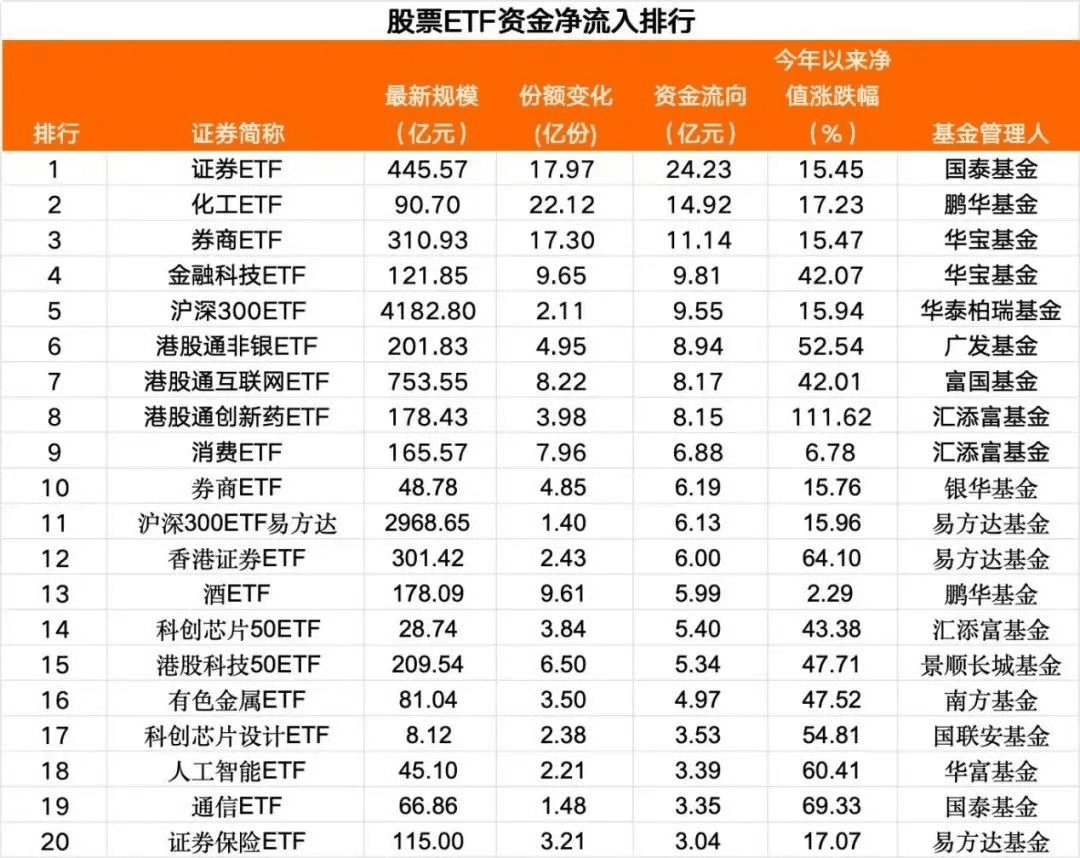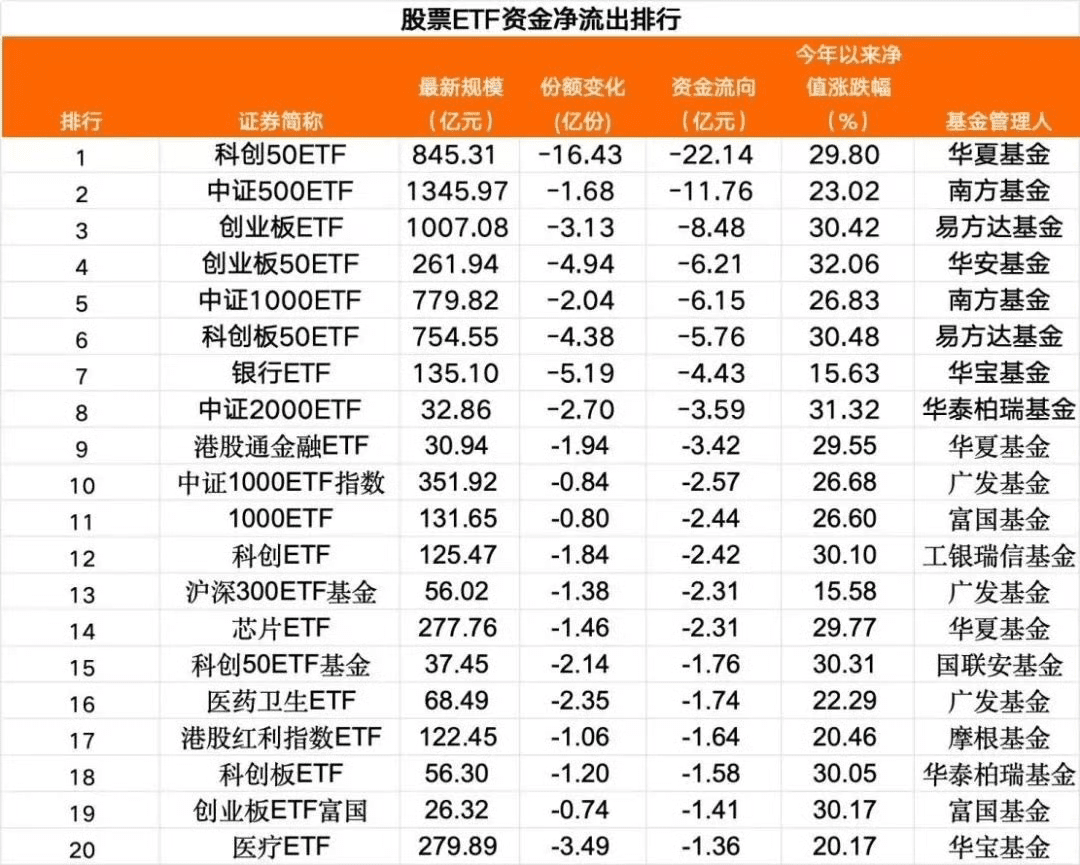On August 25, the A-share market opened high and rose further, with all three major indices closing up, and the total transaction volume of the two markets exceeded 3 trillion yuan.
Funds continued to choose to enter the market. On that day, stock ETFs had a net inflow exceeding 15.3 billion yuan, with net inflows led by industries such as securities, artificial intelligence, semiconductors, and petrochemicals, while wide-based index ETFs like the Science and Technology Innovation Board, Growth Enterprise Market, Zhongzheng 500, and Zhongzheng 1000 experienced significant outflows.
Since August, stock ETFs have shown a trend of net capital inflow, totaling over 40 billion yuan, of which ETFs related to Hong Kong stocks have seen a net inflow of 30 billion yuan.
On Monday, stock ETFs had a net inflow of 15.3 billion yuan.
According to Wind data statistics, as of August 25, the total number of stock ETFs in the market reached 1,180 (including cross-border ETFs), with a total scale of 4.21 trillion yuan.
Capital flow shows that on August 25, as the market continued to rise, stock ETFs had a net inflow of over 15.3 billion yuan.
On the day, there were 70 stock ETFs with a net capital inflow exceeding 100 million yuan, with industry ETFs leading in attracting funds. Guotai Junan Securities ETF, Penghua Chemical ETF, and Huabao Securities ETF ranked in the top three, each with a net capital inflow exceeding 1 billion yuan.
Data from E Fund shows that on August 25, the following sectors had the highest net inflows: securities (net inflow of 4.87 billion yuan), artificial intelligence (net inflow of 2.16 billion yuan), semiconductors (net inflow of 2.08 billion yuan), petrochemicals (net inflow of 1.68 billion yuan), and the CSI 300 index (net inflow of 1.66 billion yuan).
According to Wind statistics, among the top 20 stock ETFs with net inflows, industry theme ETFs such as brokerages, fintech, and science and technology chips, as well as wide-based index ETFs like the CSI 300, had the highest net inflows, and Hong Kong-related ETFs also maintained relatively high net inflows. Observing from a 5-day perspective, funds flowing into the Securities Company Index ETF exceeded 9.1 billion yuan, and those flowing into the Hang Seng Technology Index ETF exceeded 4.2 billion yuan.
Among leading fund companies, as of August 25, the latest scale of E Fund ETFs reached 760.27 billion yuan, including a net inflow of 620 million yuan in the E Fund CSI 300 ETF, a net inflow of 590 million yuan in the Hong Kong Securities ETF, a net inflow of 310 million yuan in the Securities Insurance ETF, a net inflow of 280 million yuan in the Artificial Intelligence ETF, and a net inflow of 170 million yuan in the Science and Technology Innovation Artificial Intelligence ETF.
In the China Asset Management ETF, on August 25, the Consumer Electronics ETF and the SSE 50 ETF had the highest net inflows, reaching 176 million yuan and 170 million yuan, respectively; the latest scales reached 2.701 billion yuan and 186.298 billion yuan, corresponding to the one-month average daily trading volume of the tracking indices of 168 million yuan and 2.319 billion yuan, respectively.
Wind data shows that as the only ETF in the market linked to the non-bank financial theme index of the China Securities Hong Kong Stock Connect, the scale of the non-bank ETF under GF Fund has rapidly increased. As of August 25, its latest scale has surpassed 20 billion yuan, reaching 20.183 billion yuan; the inflow of funds this year has exceeded 17.1 billion yuan. From the trend, the non-bank ETF has also been one of the leading directions this year, second only to the Hong Kong innovative drug ETF. As of August 25, the non-bank ETF has achieved a 98.56% increase in the past year, with a year-to-date increase of over 52%, ranking high among cross-border ETFs.
Some wide-based ETFs experienced significant net outflows.
On August 25, some stock ETFs experienced significant net outflows, with 31 exceeding 100 million yuan, among which wide-based ETFs such as the Science and Technology Innovation Board, Growth Enterprise Market, and Zhongzheng 500, as well as industry ETFs like banks and pharmaceuticals, experienced notable outflows.
Wind data shows that on August 25, among the top 20 stock ETFs with net outflows, wide-based ETFs had the highest net outflow. There are 5 wide-based ETFs related to the Science and Technology Innovation Board, with a net outflow of nearly 3.4 billion yuan; there are 3 ETFs related to the Growth Enterprise Market, with a net outflow exceeding 1.6 billion yuan; there are also 3 Zhongzheng 1000 ETFs, with net outflows also exceeding 1 billion yuan. In addition, a single Zhongzheng 500 ETF had a net outflow exceeding 1 billion yuan.
It is worth mentioning that since August, stock ETFs have shown a trend of net capital inflow, totaling over 40 billion yuan, with ETFs related to Hong Kong stocks having a cumulative net inflow of nearly 30 billion yuan. In contrast, ETFs related to the Science and Technology Innovation Board, Growth Enterprise Market, and semiconductor chips have experienced significant net outflows.
Fidelity Fund believes that in the medium term, with ample liquidity, the upward trend of A-shares remains unchanged, and position management may be more strategically significant than structural speculation. The technology sector is an important driving force for the new market highs in this round. After accumulating certain excess returns in overseas computing power chains, this week, stimulated by Deepseek's new version adapting to domestic chips and rumors of H20 chip production halts, the market has noticeably expanded towards the domestic ecosystem. The abundance of funds is the main support for the recent market uptrend, but the momentum of funds gathering in A-shares has not yet peaked, indicating that there may still be greater room for growth in the future.
Looking ahead, Lin Weibin, general manager of the Index Investment Department at E Fund, stated that the economic fundamentals continue to show moderate recovery, and structural opportunities in the market are expected to persist. Entering the second half of the year, the effects of policy support are gradually becoming evident, fiscal expenditures continue to accelerate, and the pace of major project construction remains steady. The combined policies in areas such as manufacturing investment, service consumption, and technological innovation provide stable support for economic operations. From the perspective of industrial structure, emerging sectors with mid-term growth potential benefit from policy tilt and technological dividends, making them attractive for mid-term allocation.